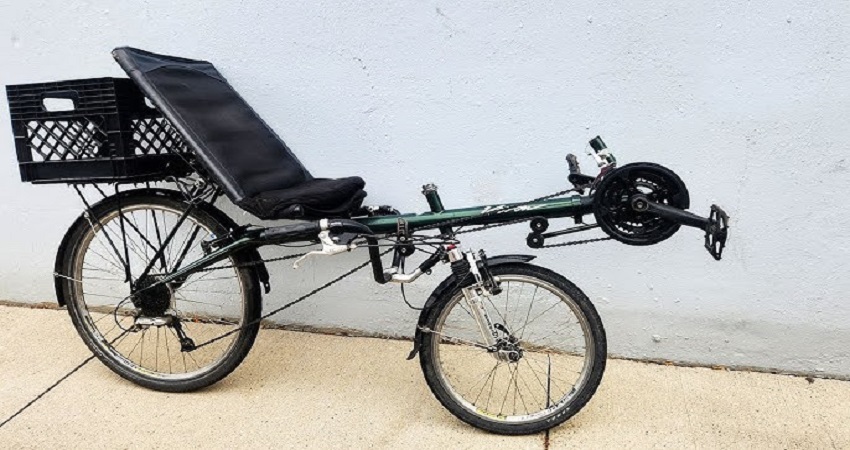
Yes, it is safe to ride a recumbent bike every day as it provides a low-impact exercise option that reduces strain on joints and allows for better posture. Riding a recumbent bike regularly can improve cardiovascular health, muscle strength, and overall fitness levels while ensuring minimal risk of injury.
Benefits Of Riding A Recumbent Bike
Riding a recumbent bike every day can have a multitude of benefits for your overall health and well-being. Not only is it a fun and enjoyable form of exercise, but it also offers several advantages that make it a great choice for individuals of all ages and fitness levels. In this section, we will explore the various benefits of riding a recumbent bike, including improved cardiovascular health, reduced joint impact, and increased muscle tone.
Improved Cardiovascular Health
Riding a recumbent bike on a regular basis can significantly improve your cardiovascular health. This low-impact form of exercise helps to strengthen your heart and increase its efficiency in pumping blood throughout your body. By engaging in a steady cycling routine, you can lower your risk of heart disease, high blood pressure, and stroke.
Reduced Joint Impact
When compared to traditional upright bikes, recumbent bikes provide a more comfortable and gentle workout experience. The reclined seating position allows your body to distribute weight evenly, reducing stress on your joints, particularly the knees and ankles. This makes recumbent biking an ideal choice for individuals with joint pain or those recovering from injuries.
Increased Muscle Tone
Regular use of a recumbent bike can help you tone and strengthen your muscles, particularly in your legs and glutes. The pushing motion required during cycling engages muscles in your thighs, calves, and buttocks, helping to build strength and improve overall muscle tone. Additionally, this form of exercise can also help in enhancing your core stability and strengthening your lower back.
Potential Safety Concerns
Riding a recumbent bike daily may have potential safety concerns that should not be overlooked. It is important to consider factors such as posture and maintaining balance to ensure a safe experience. Regular maintenance and care for the bike can also contribute to a safer riding environment.
Risk Of Back And Neck Strain
Riding a recumbent bike every day can be a wonderful way to improve your fitness and enjoy the great outdoors. However, it’s essential to be aware of the potential safety concerns associated with this form of exercise. One such concern is the risk of back and neck strain.
When you ride a recumbent bike, your body is positioned in a reclined and relaxed position. While this posture can be comfortable for many riders, it can also put stress on your back and neck if you don’t maintain proper form. You need to ensure that your back is well-supported and your head is positioned in a neutral alignment.
Here are a few tips to prevent back and neck strain when riding a recumbent bike:
- Adjust the seat and backrest to a position that provides adequate support for your spine.
- Engage your core muscles to maintain proper posture throughout your ride.
- Avoid excessive leaning or slouching, as this can strain your back and neck.
- Take frequent breaks to stretch and relax your muscles.
Limited Visibility
Another potential safety concern when riding a recumbent bike is limited visibility. Unlike traditional bicycles, recumbent bikes position the rider lower to the ground, which can reduce the rider’s visibility and make them less noticeable to other road users.
When riding a recumbent bike, it’s crucial to take extra precautions to enhance your visibility and ensure your safety on the road.
Here are some tips to improve your visibility:
- Wear brightly colored or reflective clothing to make yourself more visible to motorists.
- Attach lights or reflective accessories to your bike to increase visibility, especially when riding in low-light conditions.
- Make eye contact with drivers at intersections to ensure they see you before proceeding.
- Choose routes with bike lanes or designated cycling paths whenever possible to separate yourself from motor vehicle traffic.
Potential For Tipping Over
The potential for tipping over is another safety concern associated with recumbent bikes. Recumbent bikes have a lower center of gravity compared to traditional bicycles, making them more stable in most situations. However, certain factors can increase the risk of tipping over.
Here are some factors that can contribute to tipping over on a recumbent bike:
- Sharp turns taken at high speeds can cause the bike to tip over.
- Uneven or unstable surfaces, such as gravel or sand, can make it more challenging to maintain balance.
- Improper weight distribution can affect the bike’s stability. Ensure that you distribute your weight evenly and avoid excessive leaning.
To reduce the risk of tipping over on a recumbent bike, it’s crucial to ride at controlled speeds, especially when turning. Additionally, always be cautious when riding on uneven surfaces and maintain proper weight distribution to ensure your safety.
Tips For Safe Riding
When it comes to riding a recumbent bike, safety should always be a top priority. Whether you are a dedicated daily rider or just starting out, following these tips for safe riding will help ensure that you enjoy your cycling experience while minimizing the risk of accidents or injuries.
Proper Bike Fit And Adjustment
One of the most important aspects of safe riding is making sure that your recumbent bike is properly fit and adjusted to your body. A bike that is not set up correctly can lead to discomfort, poor posture, and even strain on your muscles or joints.
To ensure a proper bike fit:
- Adjust the seat position so that your legs have a slight bend when the pedals are at the furthest point.
- Check the handlebar height and angle to ensure a comfortable reach and grip.
- Confirm that the pedals are at a suitable distance from your feet to prevent overextension.
Wear Appropriate Safety Gear
Wearing the right safety gear is crucial for protecting yourself in case of a fall or collision. Here are some essential items to wear when riding a recumbent bike:
- A properly fitted helmet to protect your head in case of a crash or impact.
- Bright, reflective clothing to increase visibility, especially when riding during low-light conditions.
- Sturdy shoes or cycling-specific shoes with a good grip to prevent your feet from slipping off the pedals.
Choose Proper Cycling Routes
Selecting suitable cycling routes can greatly impact the safety and enjoyment of your rides. When planning your route, consider the following:
- Use designated bike lanes or paths whenever possible to minimize interaction with motor vehicles.
- Avoid busy roads or intersections with heavy traffic to reduce the risk of accidents.
- Look for routes with smooth pavement and minimal obstacles, such as potholes or loose gravel.
By following these tips for safe riding on a recumbent bike, you can confidently enjoy your daily rides while minimizing the risk of accidents or injuries. Remember, safety should always be your top priority!
Listening To Your Body
Riding a recumbent bike every day can be safe, as long as you listen to your body and avoid overexertion. Regular breaks and proper bike fit are crucial for preventing muscle strain or injury.
Understanding Your Limits
Listening to your body is crucial when it comes to riding a recumbent bike every day. Understanding your limits is the first step in maintaining a safe and healthy exercise routine. Pushing yourself too hard can lead to unwanted injuries and burnout. By paying attention to how your body feels during and after each ride, you can gauge your limits and make necessary adjustments.
Recognizing Signs Of Fatigue
Recognizing signs of fatigue is essential for preventing overexertion and potential harm. It’s important to tune in to both physical and mental cues that indicate your body needs a break. Some signs of fatigue include persistent muscle soreness, feelings of heaviness, decreased motivation, and poor concentration. If you experience any of these signs, it’s essential to prioritize rest and recovery to prevent long-term negative consequences.
Importance Of Rest And Recovery
Rest and recovery are paramount for maintaining balance in your exercise routine and ensuring long-term safety. Your body needs time to repair and rebuild itself after rigorous workouts. Without adequate rest, you risk injuries, decreased performance, and burnout. Incorporating rest days into your exercise schedule allows your muscles to regenerate and refuel, ensuring that you can continue riding your recumbent bike safely every day.
In conclusion, listening to your body is key when it comes to riding a recumbent bike daily. Understanding your limits, recognizing signs of fatigue, and prioritizing rest and recovery are essential for maintaining a safe and sustainable exercise routine. By paying attention to your body’s needs, you can enjoy the many benefits of daily recumbent bike riding while minimizing the risk of injury and burnout. Remember to always prioritize your health and well-being in your fitness journey.
Incorporating Recumbent Biking Into Daily Routine
Discover the safety and benefits of incorporating recumbent biking into your daily routine. Whether you’re seeking a low-impact exercise option or looking to improve cardiovascular health, riding a recumbent bike every day can be a safe and enjoyable way to stay active.
Recumbent biking is a fantastic way to stay active and improve your overall fitness. But is it safe to ride a recumbent bike every day? Let’s explore the benefits and considerations of incorporating recumbent biking into your daily routine and discover how to make the most out of this low-impact exercise.
Start Slow And Gradually Increase Intensity
To safely incorporate recumbent biking into your daily routine, it’s essential to start slow and gradually increase the intensity of your workouts. This will allow your body to adapt and build strength over time. Begin with shorter rides and lower resistance levels, allowing your muscles and joints to adjust to the new exercise. As you feel more comfortable, gradually increase the duration of your workouts and the resistance levels. Remember, consistency is key, so aim to ride regularly rather than pushing yourself too hard from the start.
Balancing Cycling With Other Forms Of Exercise
While recumbent biking offers excellent cardiovascular and lower body workout, it’s important to balance it with other forms of exercise to promote overall fitness and prevent overuse injuries. Consider incorporating strength training exercises, such as resistance training or bodyweight exercises, to strengthen your upper body and core.
Additionally, include flexibility exercises like yoga or stretching to improve your range of motion and prevent muscle imbalances. By diversifying your fitness routine, you can enjoy the benefits of recumbent biking while maintaining a well-rounded approach to fitness.
Seeking Professional Guidance
Seeking professional guidance when starting a new exercise routine is always a wise choice, especially if you have any existing medical conditions or concerns. A fitness professional, such as a personal trainer or physical therapist, can help you develop a customized plan that takes into account your specific needs and goals. They can guide you on proper form and techniques, ensuring that you’re maximizing the benefits of recumbent biking while minimizing the risk of injury.
Their expertise will provide you with peace of mind and a safe and effective way to incorporate recumbent biking into your daily routine. Recumbent biking can be a safe and enjoyable exercise to include in your daily routine. By starting slow and gradually increasing intensity, balancing it with other forms of exercise, and seeking professional guidance, you can make recumbent biking a sustainable and healthy habit. Remember to listen to your body, give yourself rest days, and enjoy the benefits of staying active on your recumbent bike every day!
Frequently Asked Questions Of Is It Safe To Ride A Recumbent Bike Every Day?
Is Riding A Recumbent Bike Daily Good For Your Health?
Riding a recumbent bike every day can have numerous health benefits. It improves cardiovascular fitness, strengthens leg muscles, and is easy on the joints. It also helps in burning calories, reducing stress, and improving overall fitness levels. Just make sure to start slowly and gradually increase intensity to avoid any potential injuries.
Does Riding A Recumbent Bike Help With Weight Loss?
Yes, riding a recumbent bike can be an effective tool for weight loss. It provides a low-impact cardio workout that helps burn calories and boost metabolism. By incorporating regular sessions on the recumbent bike into your fitness routine, combined with a healthy diet, you can achieve your weight loss goals.
Can Riding A Recumbent Bike Reduce Back Pain?
Yes, riding a recumbent bike can help alleviate back pain. The reclined position of the bike provides excellent back support and reduces strain on the lower back. It also promotes proper spinal alignment, which can relieve pressure on the discs and muscles in the back.
However, it’s essential to maintain correct posture and adjust the bike to your body’s optimal position.
Conclusion
Riding a recumbent bike every day is generally safe, as long as proper precautions are taken. Regular exercise can provide numerous health benefits, including improved cardiovascular fitness and weight management. However, it’s important to listen to your body, use proper technique, and consult with a healthcare professional if you have any underlying medical conditions.




